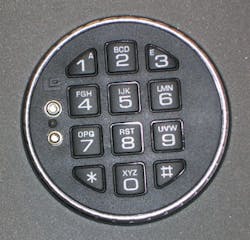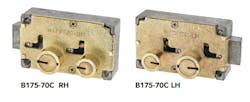Recommended service to change a safe battery(s) once a year is a good, if not great, idea to have as part of a service contract with your customers. This can be an annual “safe” checkup for the entire home, office, etc., which includes making sure the locks properly operate, adjusting door closers, and doing a site inspection for the customer’s safety. Even if you do not have a contract, keep a record and mail a post card or call once a year to keep your name in front of your customer.
NOTE: Use brand name alkaline batteries unless the manufacturer recommends something different. Extra heavy duty batteries are not alkaline.
Although many electronic safe locks are capable of operating using the same battery for more than one year, safe owners tend to not replace the battery(s) even after the “low battery” warning signs have stopped.
The customer will almost always call on a pre-weekend/holiday afternoon, saying they must have the safe opened within the next three hours (sometimes two) because it is the event of the century and the safe you sold them does not work.
The opening problem is almost always one of two scenarios. Either the combination has been lost or incorrectly remembered or the battery(s) are dead to the point the combination can not be entered in order to unlock the safe door (and the owner will usually deny that he or she using the safe even after hearing and/or seeing the warning indicators).
If you have not sold the safe, you probably will not know the make and model of the safe or the lock. As a result, you may not know how to service the safe before you see it. Ask a few questions. Is there a name on the lock? Some safe manufacturers place their name on the lock instead of leaving the lock manufacturer’s name. Another change is changing the lettering on the keypad. One lock manufacturer has changed from having “CLEAR” and “ENTER” back to “*” and “#”.
One of the ways some safe producers cause headaches for locksmiths is by changing the name and part number on a safe. The safe itself has not been changed. A new name and part number are introduced to stimulate sales. This can cause confusion in being able to identify a safe. Look at the following safes. If your safe appears to be physically the same as one of listed models but the name or part number is different, consider attempting to follow the information in order to replace the battery(s) or to unlock and open the container using the key lock override.
If the batteries are externally mounted and there is no mechanical override, try to operate the safe lock. If there is no mechanical override and the lock will not operate, only then replace all of the batteries. Check the condition of the removed batteries before installing new batteries and trying to operate the lock electronically.
To test a battery, use a voltmeter or multi-meter to check the voltage. Each 9 volt battery should indicate at least 6.6 volts. If a 9 volt battery is below 6.6 volts, replace all of the 9 volt batteries. Fresh 9 volt batteries will have voltages of 9.2 volts or more. Each AA (1.5 volt) battery should indicate should indicate at least 1.1 volts. If the AA battery is below 1.1 volts, replace all of the AA batteries. Fresh AA batteries will have voltages of approximately 1.6 volts.
When the electronic safe lock has more than one battery, be sure to replace all of the batteries at the same time. If not, the worn batteries will draw current from the new batteries, causing them to become depleted prematurely.
IMPORTANT: Whenever possible, open the door and throw the bolt before changing the battery(s). Once the battery(s) have been replaced, try the code/combination a number of times before closing the safe door.
Part 1 of our guide to servicing electronic safe locks appeared in the October 2006 issue of Locksmith Ledger, pages 48-57. The first installment addressed Securelogic Biometric Model 20700 and Electronic Pushbutton Model 20710, La Gard LG Basic II Model 3715, La Gard LG Basic Model 3710, Liverpool Lock Company Model SCS202, Promet Safe Model SE 25-EL, Securitronic Model MT-26NE, Sentry Safe Model S6770, Brinks Firesafe Model 5190D, Stack-On Safe Model PS-514, Amsec ESL 10m Brinks Model 5077D and Brinks Model 5074. The article is also available online at www.locksmithledger.com/publication/article.jsp?pubId=1&id=463.
La Gard Combogard Electronic Entry Device
LA GARD’s COMBOGARD Model 3035 Electronic Entry Device can be powered with either a 9-volt battery or six AA batteries within a box in the interior of the safe. To gain power in order to open the safe, there are contacts on the face of the lock for a 9-volt battery. To temporarily power the COMBOGARD, place a 9-volt battery’s terminals against the contacts and enter an operating code. Battery contact must be maintained at all times during the code entry and turning the keypad. If contact is lost any time during the process, the system will shutdown and the bolt will not retract.
To replace the battery(s), open safe door. Remove battery box cover by pulling the front portion away from the safe door. Remove the battery(s). Install the new battery(s). Replace the battery box cover and test the unit several times before closing the door. Note: The complete lockset is also known as the 33E.
Sentry G-4311 Safe
Sentry Model G-4311 is equipped with an external battery. The safe keypad cover lifts off to gain access to the four AA batteries. If there is a problem and the electronic lock will not operate. Lift the battery box out of the housing. Lift the battery box off from one end. Beneath the battery box is a key lock override.
S&G 6120 Electronic Combination Lock
The S&G 6120 electronic combination lock can be mated with either a one- or two-battery keypad. Both models are equipped with external battery compartments. The two 9-volt battery keypad is serviced by removing the keypad from the combination lock housing. Gently pull the keypad off from the bottom and away from the safe. Disconnect the batteries and install two new ones. When reattaching, be careful as the wires can accidentally be pinched.
The keypad style is equipped with one 9-volt battery. To gain access to the battery, there is a finger pull along the bottom of the electronic combination lock housing. To replace the battery, disengage and slowly pull down on this pull. As the finger pull lowers, the battery should slide down. Once visible, disconnect the battery and install a new one. Slide the battery and the finger pull back into the electronic combination lock. A click will sound indicating the finger pull is in the proper location.
NOTE: If the S & G lock is equipped with a biometric keypad, there will be a battery drawer at the bottom similar to the one battery keypad. Pull the finger pull to lower the two battery draw. The drawer is not designed to separate from the keypad. It will lower far enough to gain access in order to remove and install new batteries.
Kaba LC
The Kaba LC battery operated electronic combination lock is the only battery powered safe combination lock equipped with a battery. The battery in the KABA LC is in the external housing of the lock. To gain access to the 9 volt battery, the keypad must be lifted off the plastic mounting bracket. To gain access to the battery, depress the retaining button on the bottom of the lock. With the button depressed, pull the keypad away from the door while lifting up. The keypad will slide off the mounting bracket. Disconnect the battery and install a new one. Place the top of the keypad onto the mounting bracket hook. Push the bottom of the keypad against the mounting bracket to snap in place.
Access to the battery(s) can be very different between lock and safe manufacturers and models. If you are unsure, be very careful to not damage the lock’s method of mounting. Try calling the maker or the supplier where the safe was purchased. If you do not know where the safe was purchased, try to find more information using an internet search engine.






